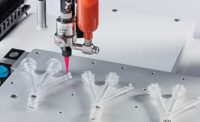Any fastener can perform well in the right application; the tricky part is selecting the right one for your intended use. For example, what materials do you need to bond? What is the size of the gap you need to fill? What temperatures and other environmental conditions will the bond face? How important is flexibility, fixture, and cure time to your application? From the beginning of the product design stage through implementation, keeping track of and continuing to pay attention to the smallest of details is of utmost importance. Otherwise, failure is inevitable.
Mark Thurber, who has worked with fastener coatings since the 1980s and now heads the specialty coatings manufacturer Tectorius, knows this situation all too well. Thus, he believes that fastener enhancements should be at the top of the list when discussing fastener selection for a part or assembly.
In the article “Highly Engineered Fastener Coatings” for the October/November 2016 issue of Fastener Technology International, Thurber posited that when considering the use and assembly of high-tech composite and plastic components, for example, “one must always arrive back to the means by which the component will be attached—the fasteners.” However, he cautions against overrelying on adhesives for such applications (“Certainly, adhesives can be used for many of the attachments,” he writes, “but they also have their shortcomings, including fixturing, cure time, nonserviceability, and outgassing”) and suggests adding highly engineered lubricants as enhancements. “One cannot expect to take strides in product advances by using the same old material choices that have been available for prior decades,” he continues. “Support materials should not be taken for granted, and must also evolve to meet the increased performance that is required by new applications and markets.”
In this interview, Thurber touches on what he’s learned about fasteners over the past 30 years, and also remarks on some recent developments and emerging trends in fastener enhancement technology.
appliance DESIGN: In your view, what are the most common causes of fastener coating problems? And how do you effectively combat these issues?
Mark Thurber, Tectorius: As with most complex systems, the old saying ‘the devil is in the details’ holds true for fasteners also. The presumption that adhesives, sealants, and coatings are universal and will work on and in any substrate or assembly has been a recurring problem I have seen throughout my career. So often, a new part is designed by carrying over some ideas from a prior version. The assumption that enhancement materials, like coatings, will still work regardless of any changes that have been made to the design, material, or intended purpose for the part is highly flawed. An example of this would be as simple as changing a plating from phosphate to dichromate on a given piece, and [thinking] that the original adhesive performance will be unaffected by that change. At Tectorius, our team has been trained to interact with new customers to fully understand all conditions our coating will be expected to perform under, so that only the best product is selected for the part type and its intended use.
How is the cause of failure determined in each instance?
Our approach of being highly interactive with the customer upfront, is the best measure for preventing failure in the field. If you are going to have failure, you want that to occur in the earliest stages of product evaluation and testing; that is the whole point of testing. From there, we can make adjustments, as needed, to ensure reliable performance once in production. I am pleased to say this practice has proven itself time and time again, and left Tectorius with an excellent quality record.
What trends in the marketplace do you see that seem to be working well?
We see some industries taking the time to engineer even seemingly mundane assemblies with great precision and forethought. Their early-stage design efforts address not only the mechanical aspects, but locking, sealing, lubrication, and corrosion—really, the full spectrum of long-term performance. As a result, we have all seen some truly astounding and durable products hit the market in recent years, many not even imaginable a decade ago. As a result, consumers return in droves for the next new version to be released, even if the unit they have is still in good shape. In the past, ‘planned obsolescence’ seemed to boil down to items wearing out early, or falling apart the moment the warranty had expired. I think it is now being recognized that this will not generate customer loyalty or a return sale. It is my hope that by way of manufacturers being open to new materials and collaboration with suppliers, ‘planned obsolescence’ has established a new meaning that includes consumer enthusiasm. What better means could there be of bolstering a brand, than to have a following of loyal customers who will gladly turn in last year’s model for the latest and greatest, without even being asked?
How are you working to make fastening and joining products more high-tech in 2017?
I always say, ‘Tectorius is a development-based company,’ meaning we are, down to our very foundation, focused on producing new and innovative products, and embracing emerging technology. It is what we do and what we enjoy doing. In addition, to offering stronger and more durable products, we will be pushing the envelope on environmentally-friendly products—not only by offering the first-level replacement of solvents with water, but also by offering materials that are lighter and by minimizing packaging. This second and third-level approach saves energy and resources related to transportation, waste, and carbon footprint—not only for us, but for our customers and everyone downstream, all the way to the consumer.






